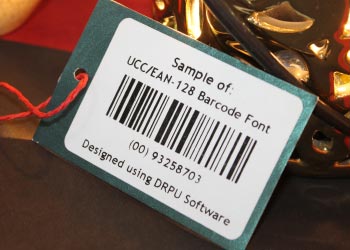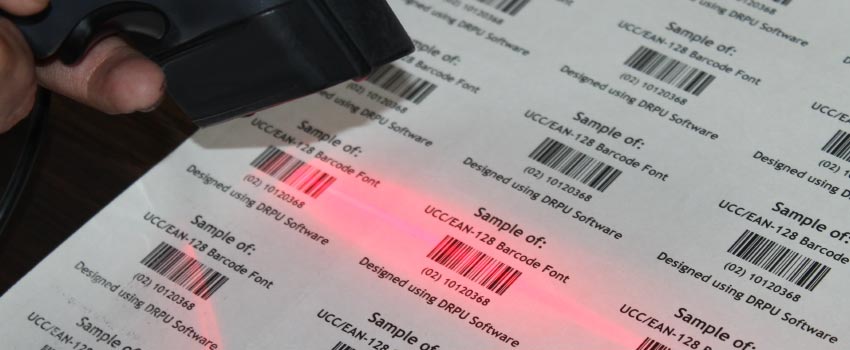The UCC/EAN-128 barcode is a type of linear barcode that uses the Code 128 symbology. It was originally developed by the Uniform Code Council (UCC) in the United States, but it is now managed by GS1, a global standards organization that oversees the development of barcode and identification standards worldwide. The UCC/EAN-128 barcode is designed to encode variable-length data, including alphanumeric characters and special symbols, making it suitable for a wide range of applications.
Generate UCC/EAN-128 Barcode
The UCC/EAN-128 barcode is based on the Code 128 symbology, which uses a combination of bars and spaces to represent data. Each character is encoded using a pattern of six bars and spaces, with each bar and space having a width that can be either one, two, three, or four units. The barcode also includes start and stop characters, which are used to identify the beginning and end of the barcode.
To generate a UCC/EAN-128 barcode, you will need a barcode generator software or online tool that supports the Code 128 symbology. There are many barcode generator tools available on the market, both free and paid, that can generate UCC/EAN-128 barcodes.
Here are the steps to generate a UCC/EAN-128 barcode:

-
⬗
Step 1: Choose a Barcode Generator Tool
The first step is to choose a barcode generator tool that supports the Code 128 symbology. Some popular barcode generator tools include Barcode Generator, Online Barcode Generator, and TEC-IT Barcode Studio. Choose a tool that is easy to use and meets your requirements.
-
⬗
Step 2: Enter Data to Encode
Once you have chosen a barcode generator tool, the next step is to enter the data that you want to encode in the barcode. The UCC/EAN-128 barcode can encode a wide range of data types, including alphanumeric characters and special symbols. Some common types of data that can be encoded in a UCC/EAN-128 barcode include:
- Product or item identification numbers
- Serial numbers
- Lot numbers
- Expiration dates
- Quantity information
- Price information
- Location information
-
⬗
Step 3: Choose Encoding Options
After entering the data to encode, you can choose encoding options, such as barcode height, width, and orientation. You can also choose whether to include a human-readable text beneath the barcode, which can be useful for manual data entry.
-
⬗
Step 4: Generate the Barcode
Once you have entered the data and chosen the encoding options, you can generate the barcode. The barcode generator tool will create a UCC/EAN-128 barcode image, which you can save as a file or print directly.
-
⬗
Step 5: Verify The Barcode
It is essential to verify that the UCC/EAN-128 barcode is scannable before using it in your business operations. You can use a barcode scanner to scan the barcode image and check that the encoded data is correct. If the barcode is not scannable, you may need to adjust the encoding options or regenerate the barcode.
Print a UCC/EAN-128 Barcode
Printing UCC/EAN-128 barcodes is an essential step in using them for inventory management and product identification. UCC/EAN-128 barcodes can encode variable-length data, making them suitable for use in a wide range of industries. They are commonly used in the healthcare, logistics, and transportation industries, among others. To print a UCC/EAN-128 barcode, you need to ensure that you have the correct printer and software, as well as the appropriate label or tag materials.
Printing UCC/EAN-128 barcodes requires a few steps to ensure that they are printed correctly and are scannable. Here is a step-by-step guide to printing UCC/EAN-128 barcodes:
-
Choose a Printer:
The first step is to choose a printer that supports UCC/EAN-128 barcode printing. Most modern printers, including inkjet, laser, and thermal printers, support UCC/EAN-128 barcode printing. However, thermal printers are the most commonly used printers for printing barcodes as they offer high-quality and durable printouts.
-
Choose Barcode Software:
Next, you need to choose barcode software that can generate and print UCC/EAN-128 barcodes. There are many software options available, both free and paid, that can generate UCC/EAN-128 barcodes. Some popular options include BarTender, NiceLabel, and LabelJoy. Choose a software that meets your needs and is compatible with your printer.
-
Design the Label or Tag:
After choosing the barcode software, you need to design the label or tag that will include the UCC/EAN-128 barcode. The label or tag should include all relevant information about the product or item being labeled, including the item number, serial number, lot number, expiration date, and any other pertinent information.
-
Generate the Barcode:
Barcode Using the barcode software, generate the UCC/EAN-128 barcode image. The software will create the barcode image in a specific format that is compatible with your printer. The software may also allow you to adjust the size and orientation of the barcode image.
-
Test the Barcode:
Before printing a large batch of labels or tags, it is essential to test the barcode to ensure that it is scannable. You can test the barcode using a barcode scanner, ensuring that the encoded data is correct and that the scanner can read the barcode.
-
Load the Labels or Tags:
Once you have tested the barcode, you can load the labels or tags into the printer. Ensure that the label or tag material is compatible with your printer and that the printer is set up correctly for the label or tag size.
-
Print the Barcode:
Using the barcode software, print the UCC/EAN-128 barcode onto the label or tag. Ensure that the barcode is printed at a high enough resolution to ensure that it is scannable. If the barcode is not scannable, you may need to adjust the printer settings or regenerate the barcode image.
-
Apply the Label or Tag:
Finally, apply the label or tag to the product or item being labeled. Ensure that the label or tag is affixed securely and that the barcode is easily scannable.
Conclusion: Printing UCC/EAN-128 barcodes requires a few essential steps to ensure that they are scannable and accurate. By choosing the correct printer and software, designing the label or tag correctly, testing the barcode, and printing at a high enough resolution, you can ensure that your UCC/EAN-128 barcodes are effective tools for inventory management and product identification.
Scan a UCC/EAN-128 Barcode
Scanning UCC/EAN-128 barcodes is a crucial step in the supply chain process. UCC/EAN-128 barcodes are used to identify and track products, manage inventory, and streamline logistics processes. Scanning these barcodes is a quick and efficient way to collect data about a product or item. In this guide, we will explain how to scan UCC/EAN-128 barcodes.

- 01 Choose the Right Scanner:
Choosing the right scanner is essential to ensure that you can scan UCC/EAN-128 barcodes effectively. There are many different types of scanners available, including handheld scanners, fixed-mount scanners, and mobile devices with built-in cameras. The most common types of scanners used to scan UCC/EAN-128 barcodes are handheld scanners and mobile devices with built-in cameras.
- 02 Position the Scanner:
To scan a UCC/EAN-128 barcode, you need to position the scanner correctly. The scanner needs to be positioned directly in front of the barcode, and the scanner's beam needs to be lined up with the barcode. The scanner should be held a few inches away from the barcode to ensure that it can read the barcode accurately.
- 03 Scan the Barcode:
To scan the barcode, point the scanner at the barcode and press the trigger button or the scan button on the device. The scanner will emit a beam of light that will reflect off the barcode and read the data encoded in the barcode. If the scanner is unable to read the barcode, adjust the scanner's position or try again with a different scanner.
- 04 Decode the Data:
Once the scanner has successfully read the barcode, the data encoded in the barcode needs to be decoded. The scanner will usually display the decoded data on the screen or send it to a computer or mobile device. The data encoded in the UCC/EAN-128 barcode can include product information such as the item number, serial number, lot number, expiration date, and any other relevant information.
- 05 Verify the Data:
After decoding the data, you need to verify that the data is correct. Check the decoded data against the product information to ensure that it matches. If the decoded data does not match the product information, investigate why there is a discrepancy and correct any errors.
- 06 Use the Data:
The data decoded from the UCC/EAN-128 barcode can be used for a variety of purposes, such as tracking inventory, managing orders, and identifying products. The data can be used to update inventory records, track the movement of products through the supply chain, and ensure that the right products are being shipped to the right customers.
Summary: Scanning UCC/EAN-128 barcodes is a critical step in managing inventory and streamlining supply chain processes. By choosing the right scanner, positioning the scanner correctly, scanning the barcode, decoding the data, verifying the data, and using the data effectively, you can ensure that your UCC/EAN-128 barcodes are effective tools for improving efficiency and accuracy in your supply chain operations.
International Usage of UCC/EAN-128 Barcode
UCC/EAN-128 barcodes can be used internationally. The UCC/EAN-128 barcode is a global standard that is widely accepted by businesses and organizations worldwide. The barcode system was created to ensure that products could be tracked and managed efficiently throughout the supply chain, regardless of their origin or destination.
- UCC/EAN-128 barcodes are based on the GS1 system, which is a global organization that sets standards for barcodes and other product identification technologies. GS1 is responsible for developing and maintaining the UCC/EAN-128 barcode standard, as well as other barcode standards such as the UPC and EAN barcodes.
- In addition to its flexibility, the UCC/EAN-128 barcode is also widely recognized and accepted by businesses and organizations around the world. This means that products labeled with UCC/EAN-128 barcodes can be scanned and tracked by companies in different countries and regions, making it easier to manage supply chain logistics across borders.
- The UCC/EAN-128 barcode standard is designed to be flexible and adaptable to different countries and industries. The barcode format can accommodate a wide range of data, including product information, batch numbers, expiration dates, and shipping information. This makes it a versatile solution that can be used in a variety of applications, from food and beverage products to pharmaceuticals, electronics, and automotive parts.
- To ensure that UCC/EAN-128 barcodes are accepted internationally, it is important to follow GS1 standards and guidelines for barcode implementation. This includes using the correct barcode format and structure, as well as ensuring that the barcode is scannable and contains accurate information.
- In some cases, businesses may need to use additional barcodes or labeling requirements to comply with local regulations and customs requirements. For example, some countries may require additional labeling for products that contain allergens or other ingredients that are regulated by law.
Conclusion: UCC/EAN-128 barcodes are a global standard that can be used internationally. The barcode system is flexible, adaptable, and widely recognized by businesses and organizations around the world. To ensure that UCC/EAN-128 barcodes are accepted internationally, it is important to follow GS1 standards and guidelines for barcode implementation, as well as comply with local regulations and customs requirements.